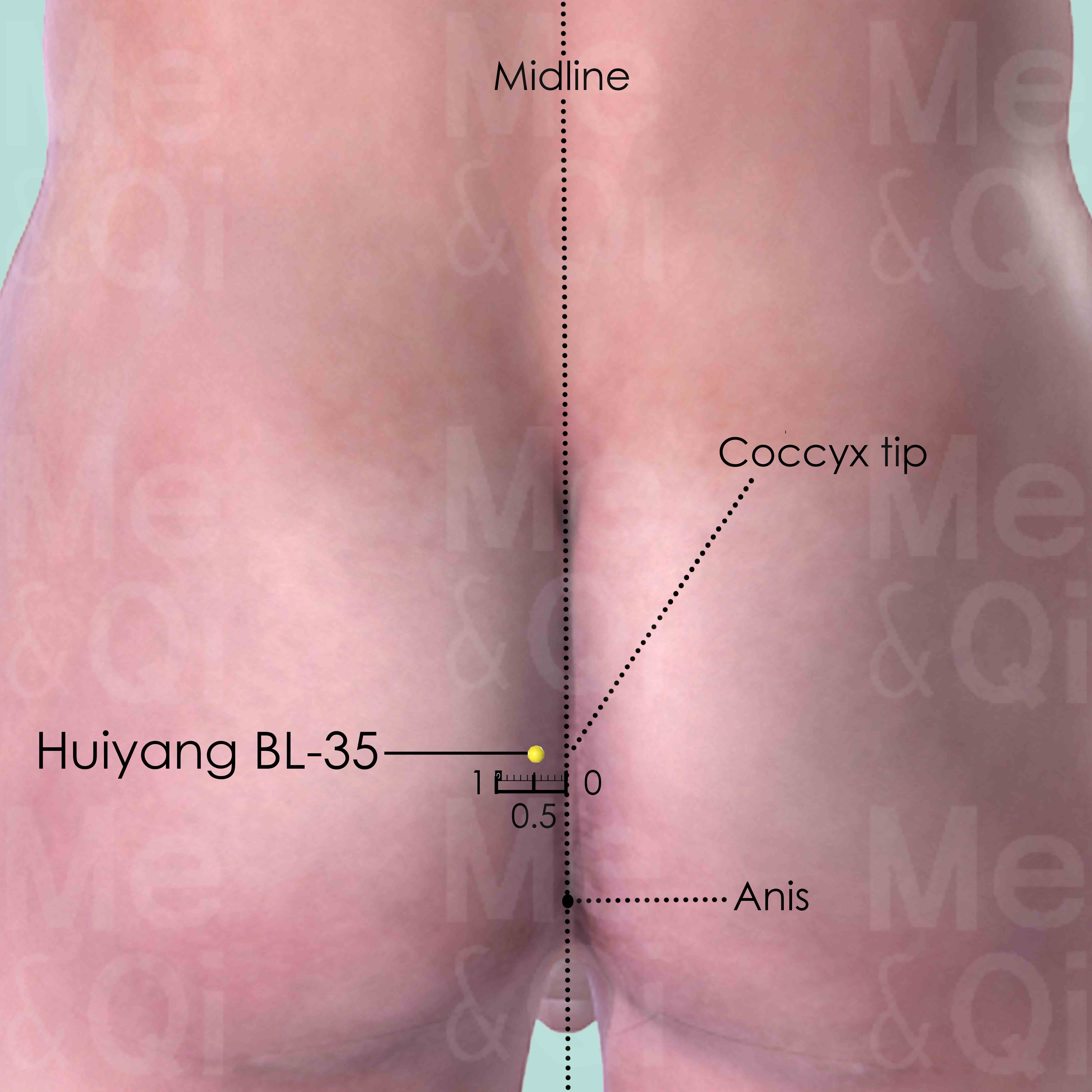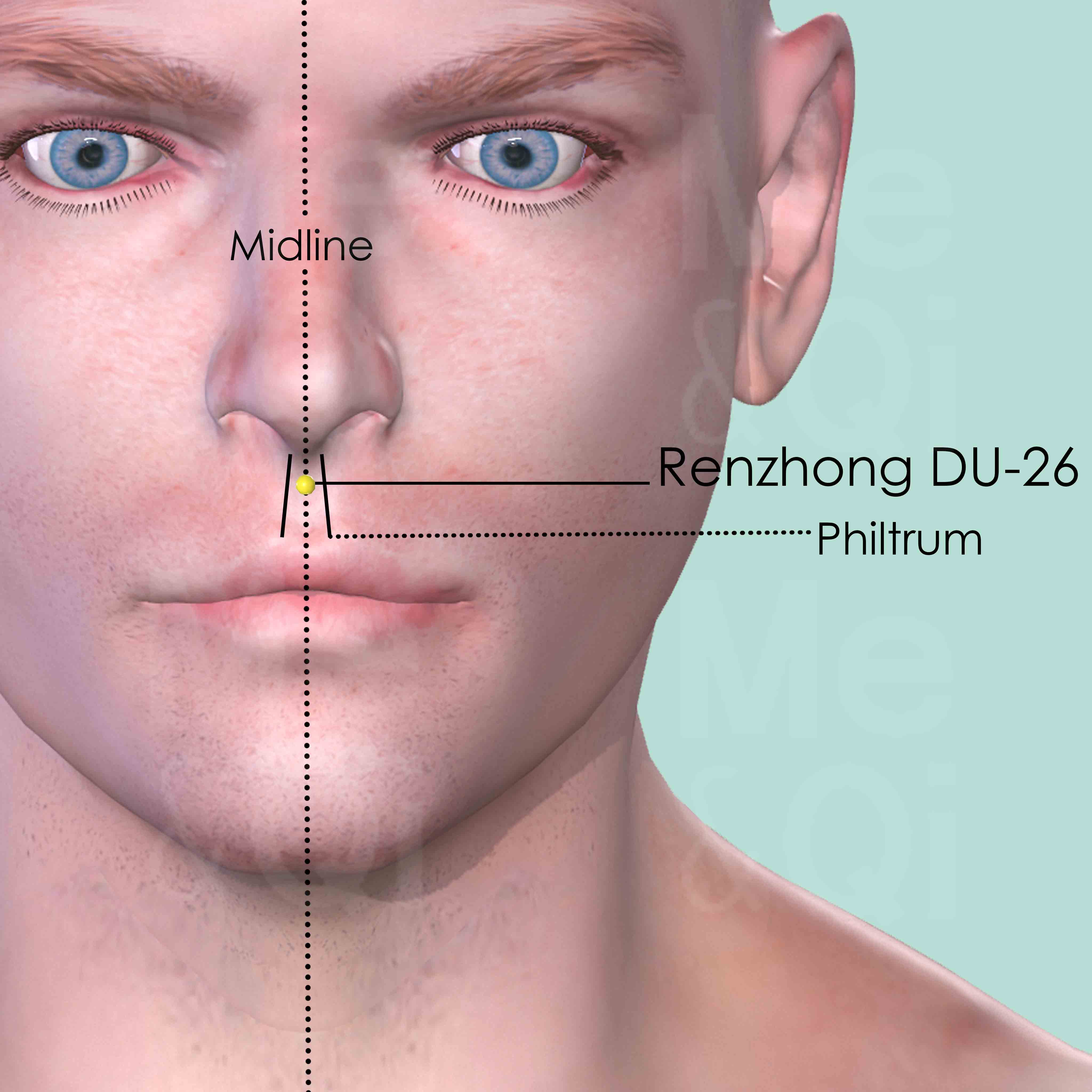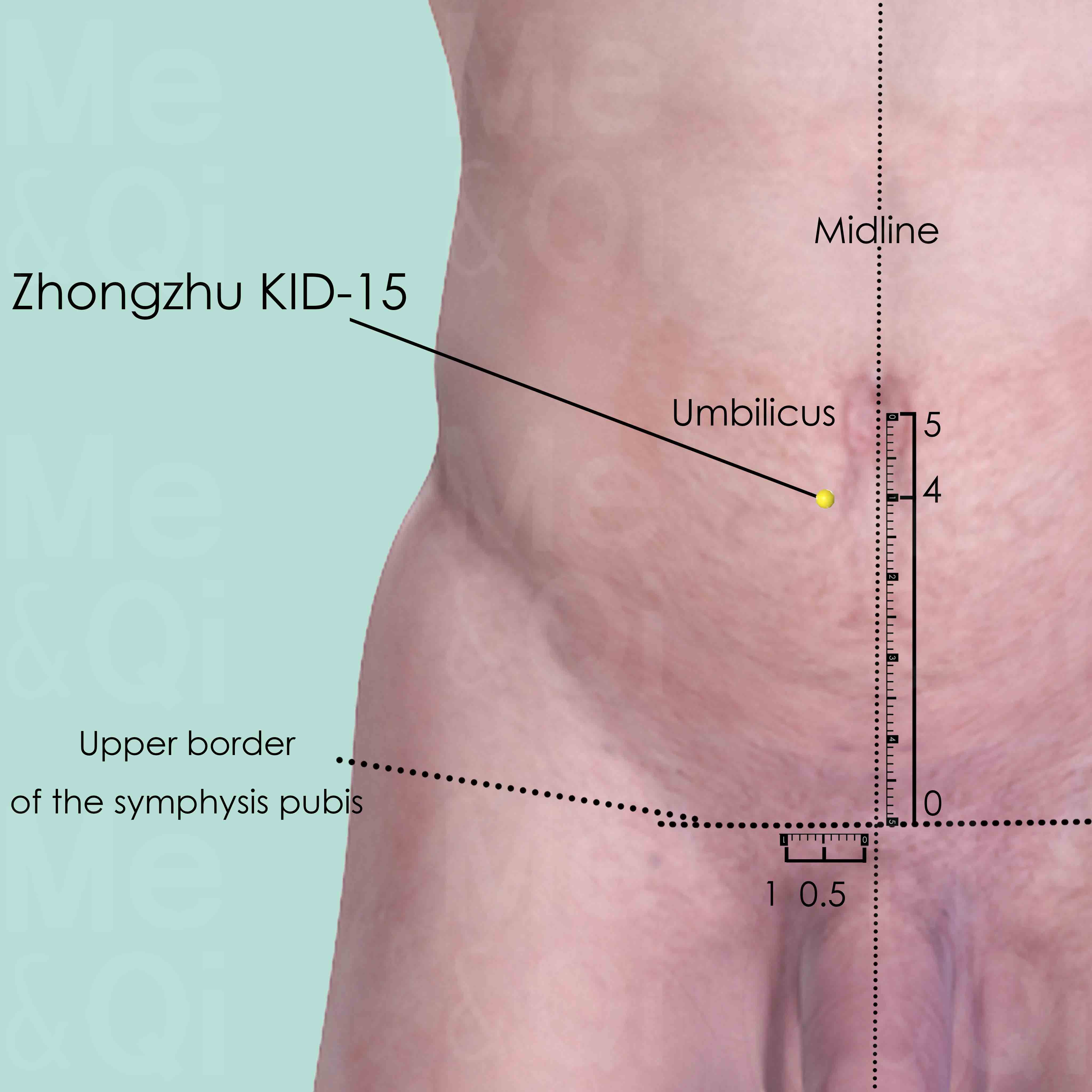Waist Painaccording to TCM
Symptom family: Back and Neck Stiffness and Discomfort
Sub-symptom(s): Lumbar Pain
Did you mean? Waist Stiffness
What is Waist Pain?
Waist pain, commonly experienced as discomfort or soreness in the waist area, is a prevalent ailment affecting many individuals. This pain can range from mild to severe and may be acute or chronic.
It often results from various factors, including muscular strain, spinal misalignment, or underlying health conditions. Waist pain is not only a physical hindrance but can also impact daily activities and quality of life, necessitating effective management and treatment.
How does TCM view Waist Pain?
Traditional Chinese Medicine (TCM) approaches waist pain with a holistic perspective, viewing it as a manifestation of imbalances within the body's vital energy, known as Qi, and the harmony of Yin and Yang.
TCM practitioners consider factors such as Qi stagnation, blood flow disruptions, and the invasion of external elements like Cold or Dampness. The treatment in TCM focuses on restoring balance, enhancing Qi flow, and addressing the root cause of the imbalance, rather than just alleviating symptoms.
Root Causes of Waist Pain in TCM
In TCM, waist pain is often attributed to specific patterns of imbalance. One such cause is the Kidney Yin Deficiency, leading to a condition known as "Empty-Heat." This imbalance results in symptoms like waist pain and soreness, night sweats, and a feeling of heat, particularly in the palms and soles.
Another common TCM pattern associated with waist pain is Damp-Cold invasion, where external cold and dampness enter the body, leading to symptoms like waist discomfort, chills, and joint pain. TCM treatments for these conditions focus on nourishing Yin and dispelling Damp-Cold to alleviate pain and restore internal harmony.
Explore below more details about what might cause Waist pain according to TCM.
Yang Deficiency
Yang deficiency in TCM refers to a state where the body's Yang energy, which is responsible for warmth, activity, and function, is weakened or diminished. This pattern of disharmony often arises from chronic illness, aging, or inherent constitutional weakness. Symptoms of Yang deficiency are typically associated with cold and sluggishness, such as a feeling of coldness, cold extremities, pale complexion, low energy or fatigue, and a desire for warmth. Digestive issues like poor appetite, loose stools, and water retention can also be indicative of Yang deficiency.... see more
Yang Deficiency Patterns That Can Lead to Waist Pain
Common Symptoms: Lumbar Pain Edema Of The Lower Extremities Cold Sensation In Legs And Back Abdominal Distention Chills Scanty Clear Urination Palpitations Shortness Of Breath
| Pattern Name | Relevant Symptoms | Relevant Formulas |
|---|---|---|
| Kidney Yang Deficiency with Water overflowing | Soreness of the lower back, Edema of the lower extremities, Cold sensation in legs and back, Abdominal distention, Lumbar pain, Chills, Scanty clear urination, Palpitations, Shortness of breath, Cold hands, White and watery sputum, Coughing, Asthma... see more | Wu Ling San | Ji Sheng Shen Qi Wan |
| Wind-Cold invading with Yang Deficiency | Soreness of the lower back, Low grade fever, Severe chills, Exhaustion, Hypersomnia, Cold extremities, Lumbar pain, Lower back pain, Lower back coldness, General cold feeling, Lack of sweating, Headaches, Weak voice... see more | Ma Huang Xi Xin Fu Zi Tang | Zai Zao San |
Cold
In TCM "Cold" as a pattern of disharmony refers to a specific type of imbalance within the body's systems, often linked to a deficiency or weakness. It's not about feeling physically cold or having a common cold, but rather a metaphorical description of certain symptoms and underlying conditions. When a TCM practitioner says someone suffers from "Cold," it usually implies that the body's Yang energy, which is warm and active, is insufficient or overpowered by Yin energy, which is cool and passive. Symptoms of Cold in TCM can include a general feeling of coldness, cold limbs, pale complexion, low energy, slow metabolism, and a preference for warmth. ... see more
Cold Patterns That Can Lead to Waist Pain
Common Symptoms: Cold Extremities Mouth Ulcers White And Watery Sputum Nasal Discharge Sneezing Chills Abdominal Pain Arthralgia
| Pattern Name | Relevant Symptoms | Relevant Formulas |
|---|---|---|
| Damp-Cold | Waist pain and soreness, Mouth ulcers, White and watery sputum, Nasal discharge, Sneezing, Chills, Abdominal pain, Cold extremities, Arthralgia, Diarrhea, Feeling of heaviness... see more | Wei Ling Tang |
| Wind-Cold invading with Yang Deficiency | Soreness of the lower back, Low grade fever, Severe chills, Exhaustion, Hypersomnia, Cold extremities, Lumbar pain, Lower back pain, Lower back coldness, General cold feeling, Lack of sweating, Headaches, Weak voice... see more | Ma Huang Xi Xin Fu Zi Tang | Zai Zao San |
Dampness
"Dampness" in TCM is a concept that describes a pattern of disharmony where the body accumulates excess moisture. Imagine the heavy, sticky feeling you get on a very humid day; that's similar to what dampness feels like internally. It can manifest as a sense of heaviness, bloating, sluggishness, or even a foggy mind. This condition is often thought to arise from environmental factors like living in a damp place, dietary habits that promote moisture in the body, or internal imbalances that hinder the body's ability to process fluids properly. In TCM, dampness can obstruct the normal flow of energy and fluids in the body, leading to various symptoms.... see more
Dampness Patterns That Can Lead to Waist Pain
Common Symptoms: White And Watery Sputum Chills Mouth Ulcers Nasal Discharge Sneezing Abdominal Pain Cold Extremities Arthralgia
| Pattern Name | Relevant Symptoms | Relevant Formulas |
|---|---|---|
| Damp-Cold | Waist pain and soreness, Mouth ulcers, White and watery sputum, Nasal discharge, Sneezing, Chills, Abdominal pain, Cold extremities, Arthralgia, Diarrhea, Feeling of heaviness... see more | Wei Ling Tang |
| Kidney Yang Deficiency with Water overflowing | Soreness of the lower back, Edema of the lower extremities, Cold sensation in legs and back, Abdominal distention, Lumbar pain, Chills, Scanty clear urination, Palpitations, Shortness of breath, Cold hands, White and watery sputum, Coughing, Asthma... see more | Wu Ling San | Ji Sheng Shen Qi Wan |
Yin Deficiency
Yin deficiency in TCM is a pattern of disharmony characterized by a depletion of the body's Yin energy, which represents the cooling, moistening, and nurturing aspects of our physiology. This condition often arises from factors like chronic stress, overwork, insufficient rest, or prolonged illness. Symptoms of Yin deficiency can include a sensation of heat, especially in the afternoon or evening, night sweats, insomnia, a dry mouth or throat, and a red tongue with little coating. There might also be a general feeling of restlessness or irritability. Since Yin is essential for balancing the body's active and warm Yang energy, its deficiency leads to a relative excess of Yang, manifesting as heat or dryness symptoms.... see more
Yin Deficiency Patterns That Can Lead to Waist Pain
| Pattern Name | Relevant Symptoms | Relevant Formulas |
|---|---|---|
| Empty-Heat caused by Yin Deficiency | Waist pain and soreness, Nighttime fever, Emaciation, Chronic pyelonephritis, Pulmonary tuberculosis, Renal tuberculosis, Tidal fever, Hot palms and soles, Red skin eruptions, Night sweats, Generalized fatigue... see more | Qing Hao Bie Jia Tang |
Heat
In TCM "Heat" signifies an excess of Yang energy, leading to an imbalance where heat predominates over the body's cool Yin aspects. This condition is metaphorically akin to an internal over-heating. Symptoms indicative of Heat can include feelings of warmth, fever, sweating, irritability, red face, thirst with a preference for cold drinks, and a rapid pulse. The tongue may appear red with a yellow coating. Unlike the common interpretation of heat in terms of temperature, in TCM, it represents a state of hyperactivity or inflammation in the body.... see more
Heat Patterns That Can Lead to Waist Pain
| Pattern Name | Relevant Symptoms | Relevant Formulas |
|---|---|---|
| Empty-Heat caused by Yin Deficiency | Waist pain and soreness, Nighttime fever, Emaciation, Chronic pyelonephritis, Pulmonary tuberculosis, Renal tuberculosis, Tidal fever, Hot palms and soles, Red skin eruptions, Night sweats, Generalized fatigue... see more | Qing Hao Bie Jia Tang |
Wind
In TCM "Wind" is a concept that represents a pattern of disharmony, often characterized by its sudden and unpredictable nature, much like a gusty wind changing direction without warning. This pattern is associated with symptoms that come and go quickly or move around the body, such as itching, tremors, or even certain types of pain. Wind is considered to be a primary cause of illnesses that have these rapidly changing characteristics. In TCM, external Wind often refers to illnesses that start suddenly, like the common cold, believed to be caused by external pathogenic factors like climatic changes. On the other hand, internal Wind can be linked to internal imbalances and can manifest in conditions like dizziness or spasms. ... see more
Wind Patterns That Can Lead to Waist Pain
| Pattern Name | Relevant Symptoms | Relevant Formulas |
|---|---|---|
| Wind-Cold invading with Yang Deficiency | Soreness of the lower back, Low grade fever, Severe chills, Exhaustion, Hypersomnia, Cold extremities, Lumbar pain, Lower back pain, Lower back coldness, General cold feeling, Lack of sweating, Headaches, Weak voice... see more | Ma Huang Xi Xin Fu Zi Tang | Zai Zao San |
Kidney
In TCM the Kidneys are regarded as the body's most fundamental reservoir of Essence, known as Jing, which influences growth, reproduction, and aging. They are not just organs for filtering blood, but a holistic system governing vital life forces. When the Kidneys malfunction in TCM, it can manifest as a variety of health issues, such as chronic fatigue, reproductive problems, imbalances in fluid metabolism leading to edema or dryness, lower back pain, and a sense of fear or insecurity.... see more
Kidney Patterns That Can Lead to Waist Pain
| Pattern Name | Relevant Symptoms | Relevant Formulas |
|---|---|---|
| Kidney Yang Deficiency with Water overflowing | Soreness of the lower back, Edema of the lower extremities, Cold sensation in legs and back, Abdominal distention, Lumbar pain, Chills, Scanty clear urination, Palpitations, Shortness of breath, Cold hands, White and watery sputum, Coughing, Asthma... see more | Wu Ling San | Ji Sheng Shen Qi Wan |
TCM Herbal Formulas for Waist Pain
TCM offers a range of herbal formulas tailored to the specific cause of waist pain. For instance, Qing Hao Bie Jia Tang, a formula containing Softshell Turtle Shells, is used to clear heat arising from Yin deficiency. This formula helps cool down the body and alleviate symptoms associated with Empty-Heat.
In cases of Damp-Cold causing waist pain, Wei Ling Tang, featuring Water plantain, is recommended to expel dampness and warm the body. These formulas are chosen based on a careful assessment of the individual's unique TCM pattern, ensuring a targeted and effective treatment approach.
Explore below some TCM herbal formulas used to address waist pain, organized by cause and by formula type.
- By Cause
- By Formula Type
- Yang Deficiency
- Cold
- Dampness
- Yin Deficiency
- Heat
- Wind
- View More Causes
- Formulas that clear exterior disorders with interior deficiency
- Formulas that expel dampness
- Formulas that clear heat from deficiency
- Formulas that warm the meridians and disperse cold
- Formulas that dispel wind-Damp
- Formulas that dredge and disperse external wind
- Formulas that promote urination and leach out dampness
- Formulas that warm yang and tonify
Top Formula for Yang Deficiency:
Wu Ling San
Suitable for Yang Deficiency patterns that may cause waist pain, such as Kidney Yang Deficiency with Water overflowing
Learn moreAll Formulas Recommended for Waist Pain Caused by Yang Deficiency
| Formula | Patterns Suitable For |
|---|---|
| Wu Ling San | Kidney Yang Deficiency with Water overflowing |
| Ji Sheng Shen Qi Wan | Kidney Yang Deficiency with Water overflowing |
| Ma Huang Xi Xin Fu Zi Tang | Wind-Cold invading with Yang Deficiency |
| Zai Zao San | Wind-Cold invading with Yang Deficiency |
Top Formula for Cold:
Wei Ling Tang
Suitable for Cold patterns that may cause waist pain, such as Damp-Cold
Learn moreAll Formulas Recommended for Waist Pain Caused by Cold
| Formula | Patterns Suitable For |
|---|---|
| Wei Ling Tang | Damp-Cold |
| Ma Huang Xi Xin Fu Zi Tang | Wind-Cold invading with Yang Deficiency |
| Zai Zao San | Wind-Cold invading with Yang Deficiency |
Top Formula for Dampness:
Wei Ling Tang
Suitable for Dampness patterns that may cause waist pain, such as Damp-Cold
Learn moreAll Formulas Recommended for Waist Pain Caused by Dampness
| Formula | Patterns Suitable For |
|---|---|
| Wei Ling Tang | Damp-Cold |
| Wu Ling San | Kidney Yang Deficiency with Water overflowing |
| Ji Sheng Shen Qi Wan | Kidney Yang Deficiency with Water overflowing |
Top Formula for Yin Deficiency:
Qing Hao Bie Jia Tang
Suitable for Yin Deficiency patterns that may cause waist pain, such as Empty-Heat caused by Yin Deficiency
Learn moreTop Formula for Heat:
Qing Hao Bie Jia Tang
Suitable for Heat patterns that may cause waist pain, such as Empty-Heat caused by Yin Deficiency
Learn moreTop Formula for Wind:
Ma Huang Xi Xin Fu Zi Tang
Suitable for Wind patterns that may cause waist pain, such as Wind-Cold invading with Yang Deficiency
Learn moreAll Formulas Recommended for Waist Pain Caused by Wind
| Formula | Patterns Suitable For |
|---|---|
| Ma Huang Xi Xin Fu Zi Tang | Wind-Cold invading with Yang Deficiency |
| Zai Zao San | Wind-Cold invading with Yang Deficiency |
Formulas that clear Exterior disorders with Interior deficiency
These formulas are suitable for some waist pain-causing patterns like Wind-Cold invading with Yang Deficiency.
One such formula is Ma Huang Xi Xin Fu Zi Tang, with ephedra as a key herb.
Other formulas of this category are listed in the table below.
All "formulas that clear exterior disorders with interior deficiency" recommended for waist pain
| Formula | Patterns Suitable For (if applicable) |
|---|---|
| Ma Huang Xi Xin Fu Zi Tang | Wind-Cold invading with Yang Deficiency |
| Zai Zao San | Wind-Cold invading with Yang Deficiency |
Formulas that expel Dampness
These formulas are suitable for some waist pain-causing patterns like Damp-Cold.
One such formula is Wei Ling Tang, with water plantain as a key herb.
Formulas that clear Heat from Deficiency
These formulas are suitable for some waist pain-causing patterns like Empty-Heat caused by Yin Deficiency.
One such formula is Qing Hao Bie Jia Tang, with softshell turtle shell as a key herb.
Formulas that warm the Meridians and disperse Cold
These formulas are suitable for some waist pain-causing patterns like Painful Obstruction.
One such formula is Wu Tou Tang, with prepared sichuan aconite as a key herb.
Formulas that dispel Wind-Damp
These formulas are suitable for some waist pain-causing patterns like Painful Obstruction.
One such formula is Da Fang Feng Tang, with saposhnikovia root as a key herb.
Formulas that dredge and disperse External Wind
These formulas are suitable for some waist pain-causing patterns like Painful Obstruction.
One such formula is Xiao Huo Luo Dan, with prepared kusnezoffii aconite as a key herb.
Formulas that promote urination and leach out Dampness
These formulas are suitable for some waist pain-causing patterns like Kidney Yang Deficiency with Water overflowing.
One such formula is Wu Ling San, with water plantain as a key herb.
Formulas that warm Yang and tonify
These formulas are suitable for some waist pain-causing patterns like Kidney Yang Deficiency with Water overflowing.
One such formula is Ji Sheng Shen Qi Wan, with prepared aconite as a key herb.
Acupoints for Waist Pain
TCM also incorporates acupuncture as a vital component of treatment for waist pain. Specific acupoints like Zhongshu DU-7, located on the back midline below the spinous process of the 10th thoracic vertebra, are used.
Stimulating this point can tonify the Middle Burner and benefit the spine, aiding in the relief of waist pain. Acupuncture, combined with herbal medicine, offers a comprehensive approach to treating waist pain, focusing on the individual's overall well-being and the restoration of balance within the body.
Explore below some acupoints used to address waist pain, organized by meridian.
- By Meridian
- Bladder Channel
- Governing Vessel
- Gall Bladder Channel
- Extra Points: Upper Extremities (EX-UE)
- Extra Points: Back (EX-B)
- Kidney Channel
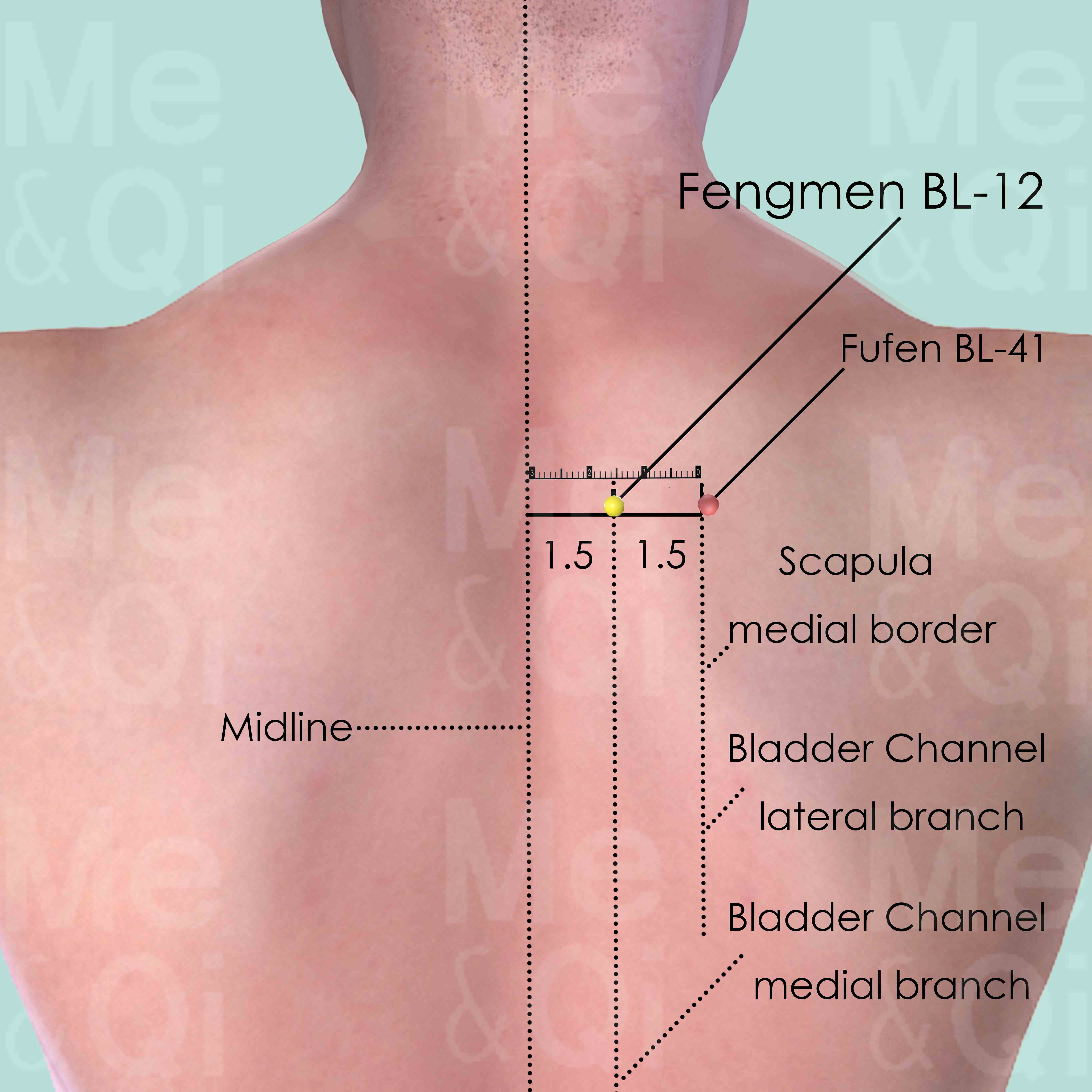
Fengmen BL-12
1.5 cun lateral to the lower border of the spinous process of the 2nd thoracic vertebra (T2).
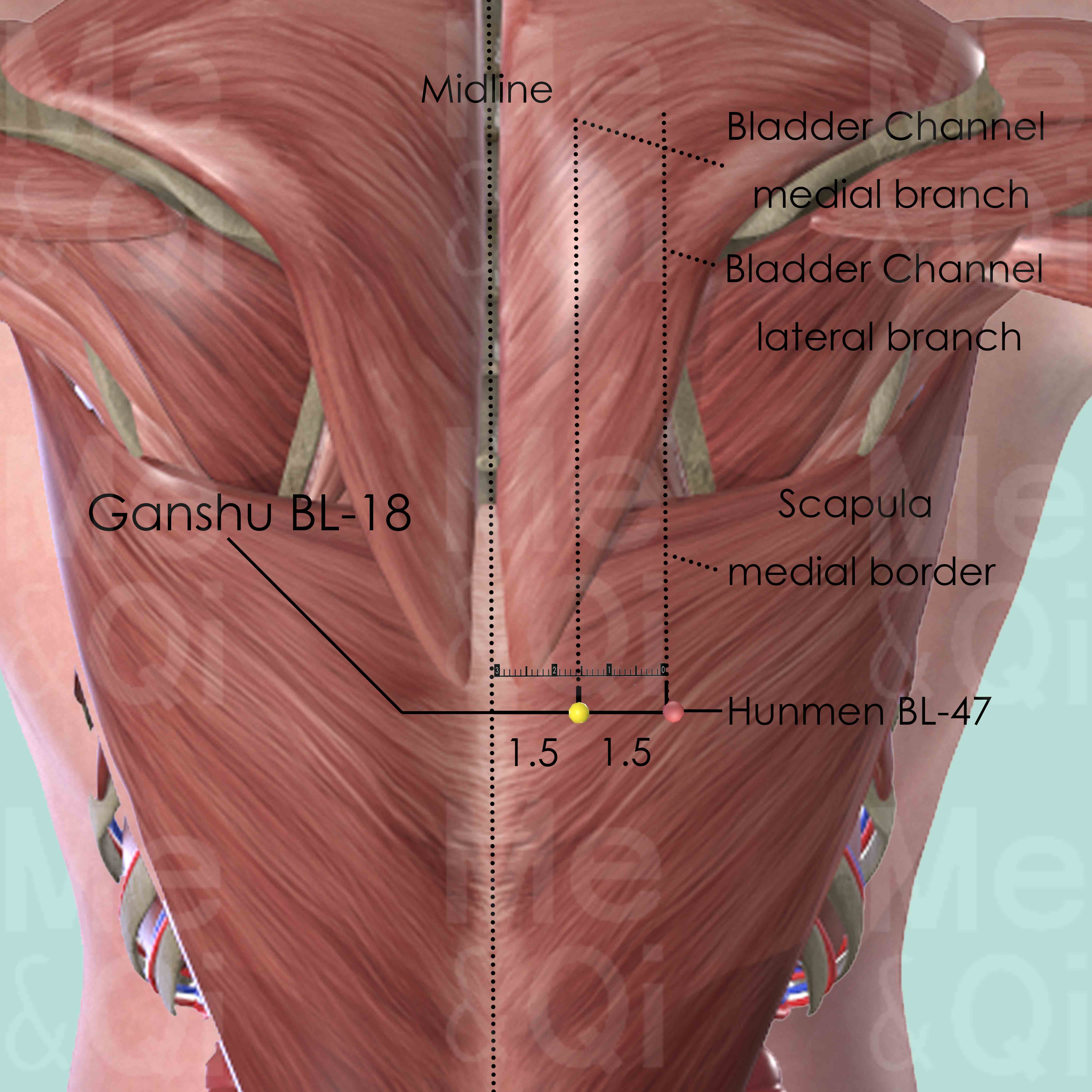
Ganshu BL-18
1.5 cun lateral to the lower border of the spinous process of the 9th thoracic vertebra (T9).
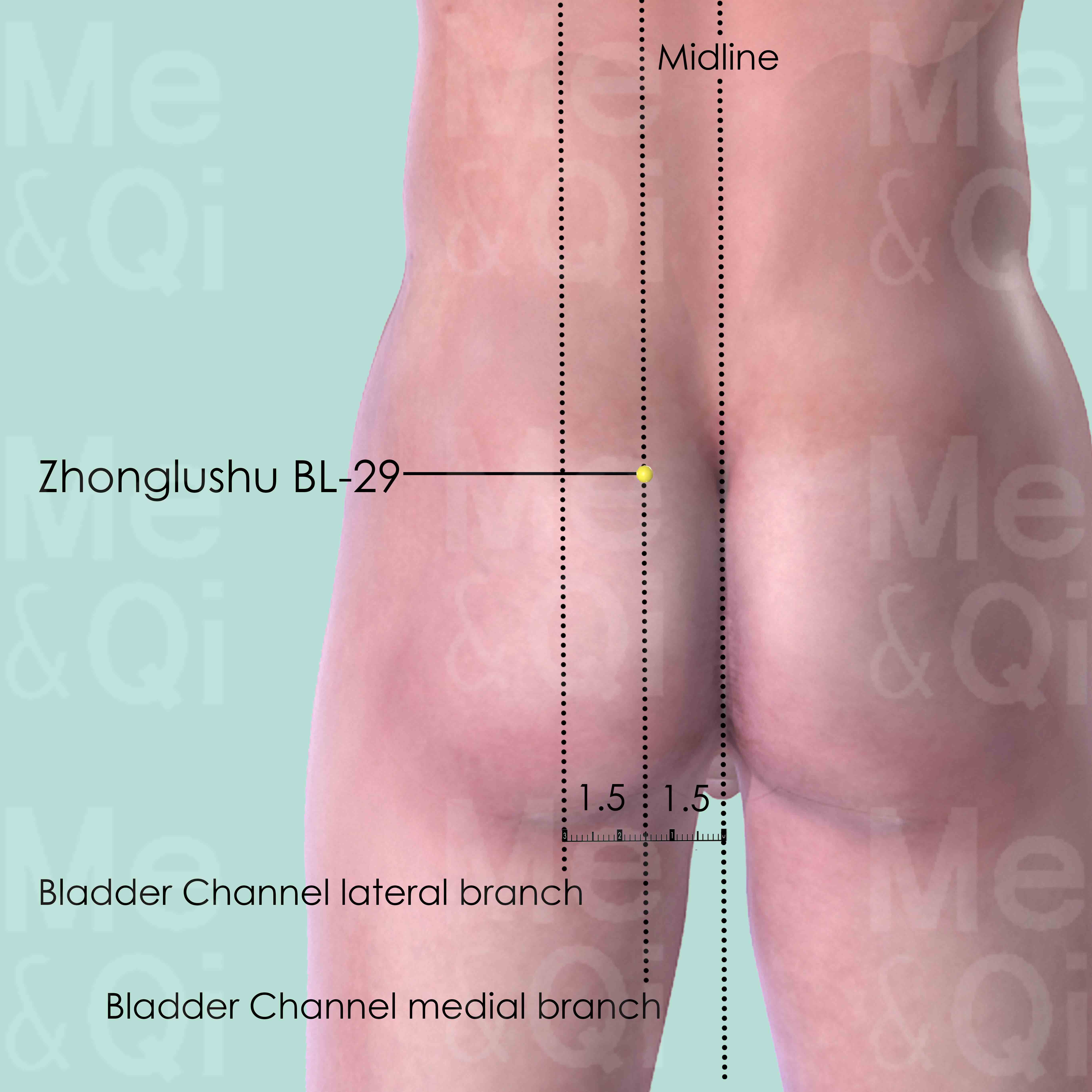
Zhonglushu BL-29
At the level of the 3rd posterior sacral foramen, 1.5 cun lateral to the posterior midline.
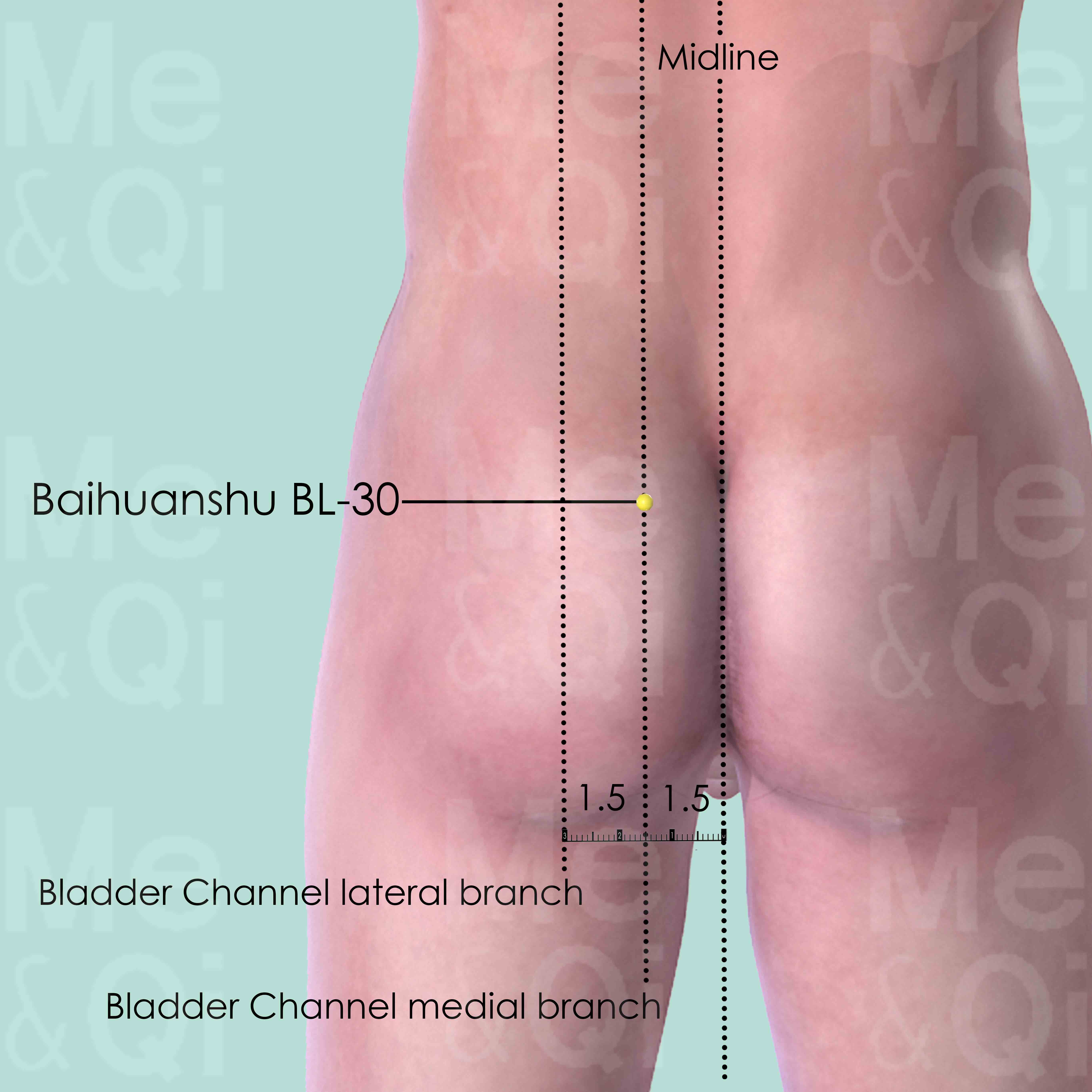
Baihuanshu BL-30
At the level of the 4th posterior sacral foramen, 1.5 cun lateral to the posterior midline.
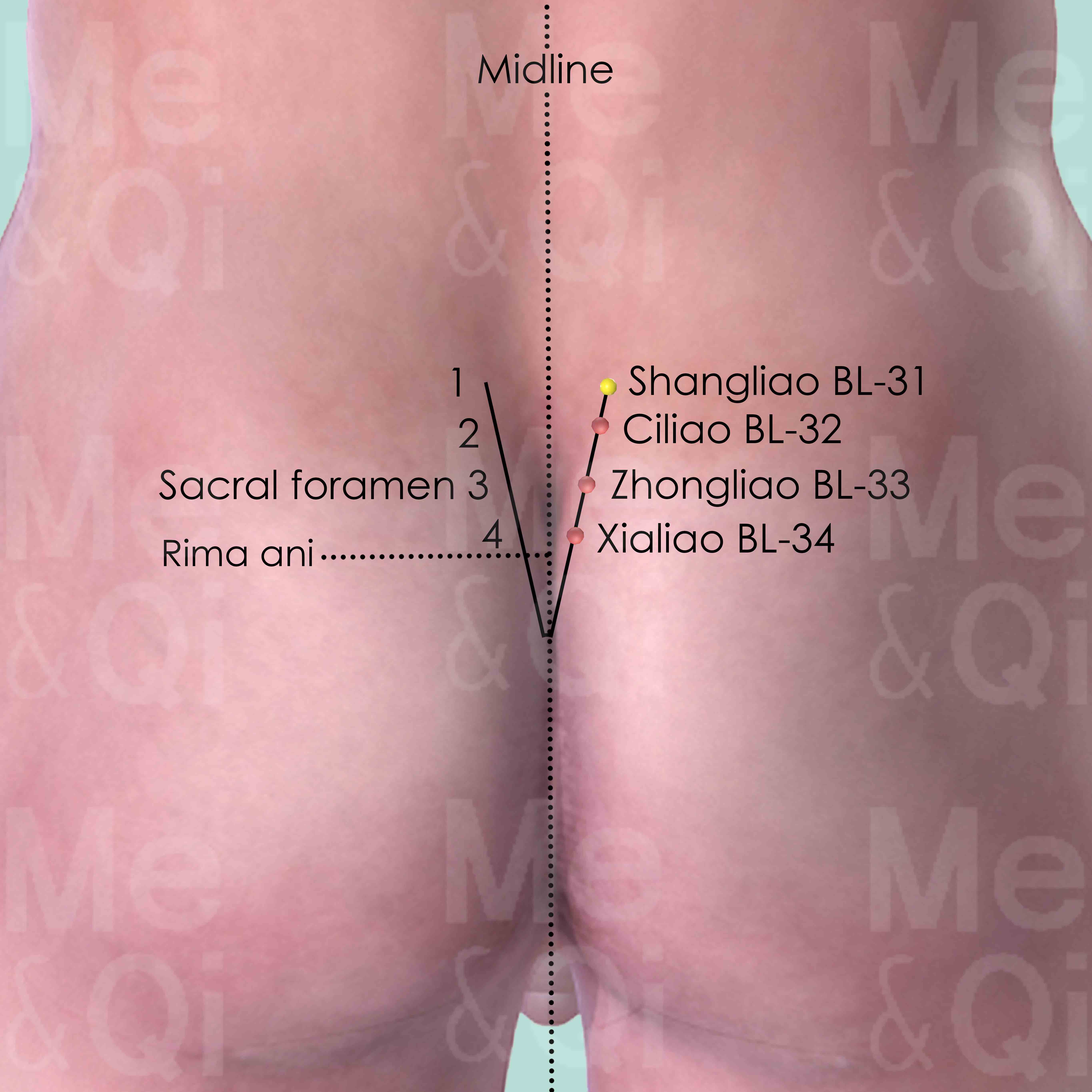
Shangliao BL-31
In the 1st posterior sacral foramen, about midway between the posterior superior iliac spine (PSIS) and the midline.
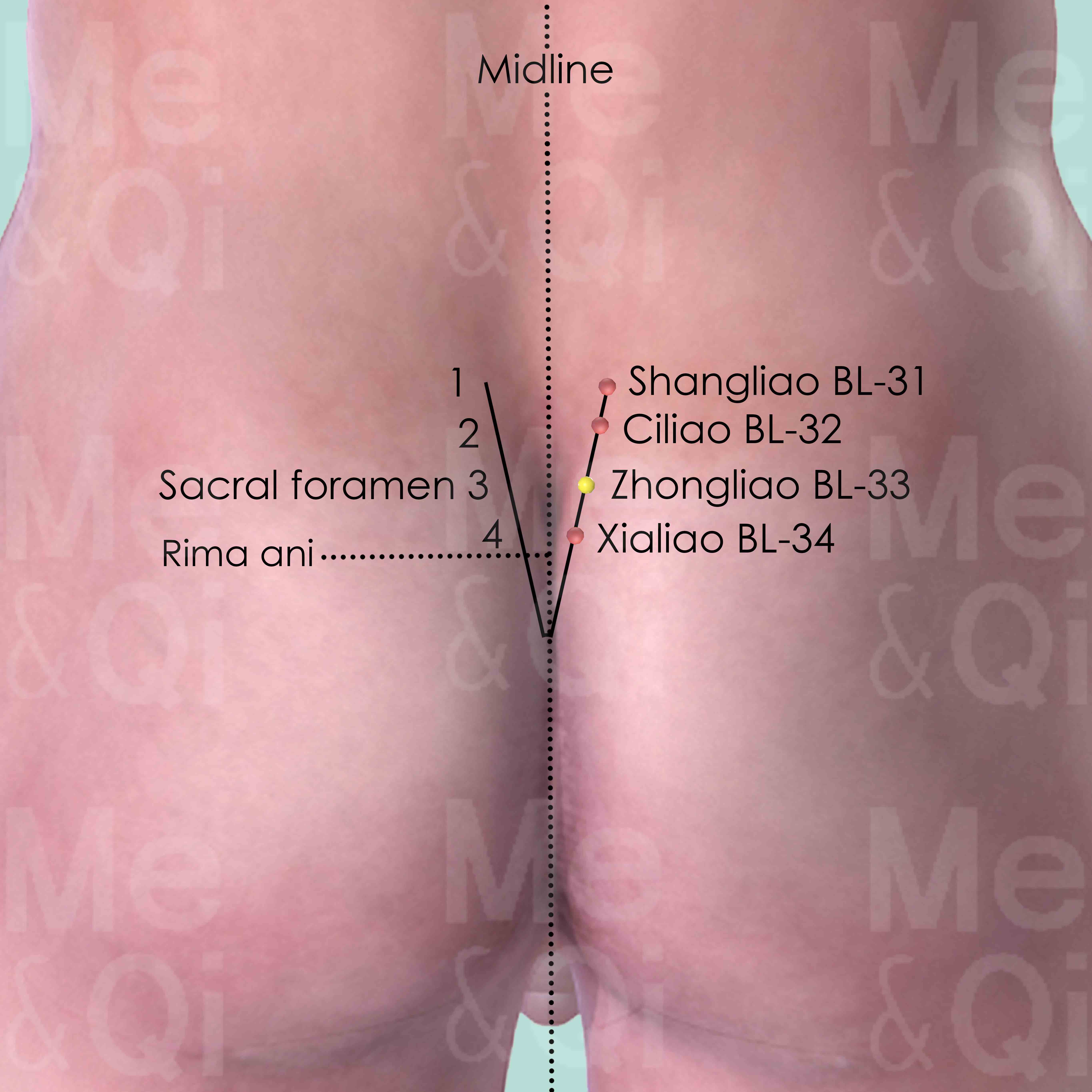
Zhongliao BL-33
In the 3rd posterior sacral foramen, between the posterior superior iliac spine and the midline.
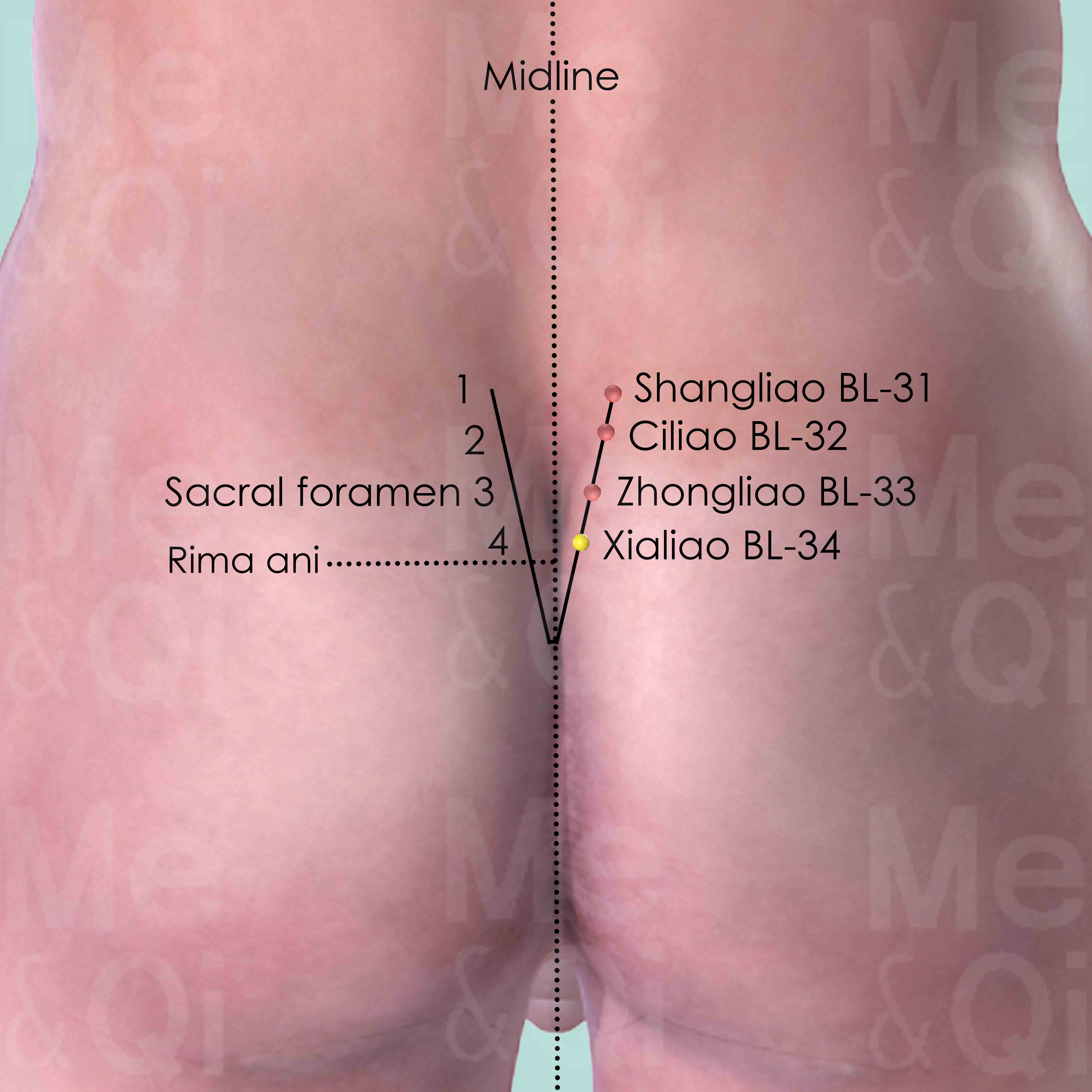
Xialiao BL-34
In the 4th posterior sacral foramen, between the posterior superior iliac spine and the midline.
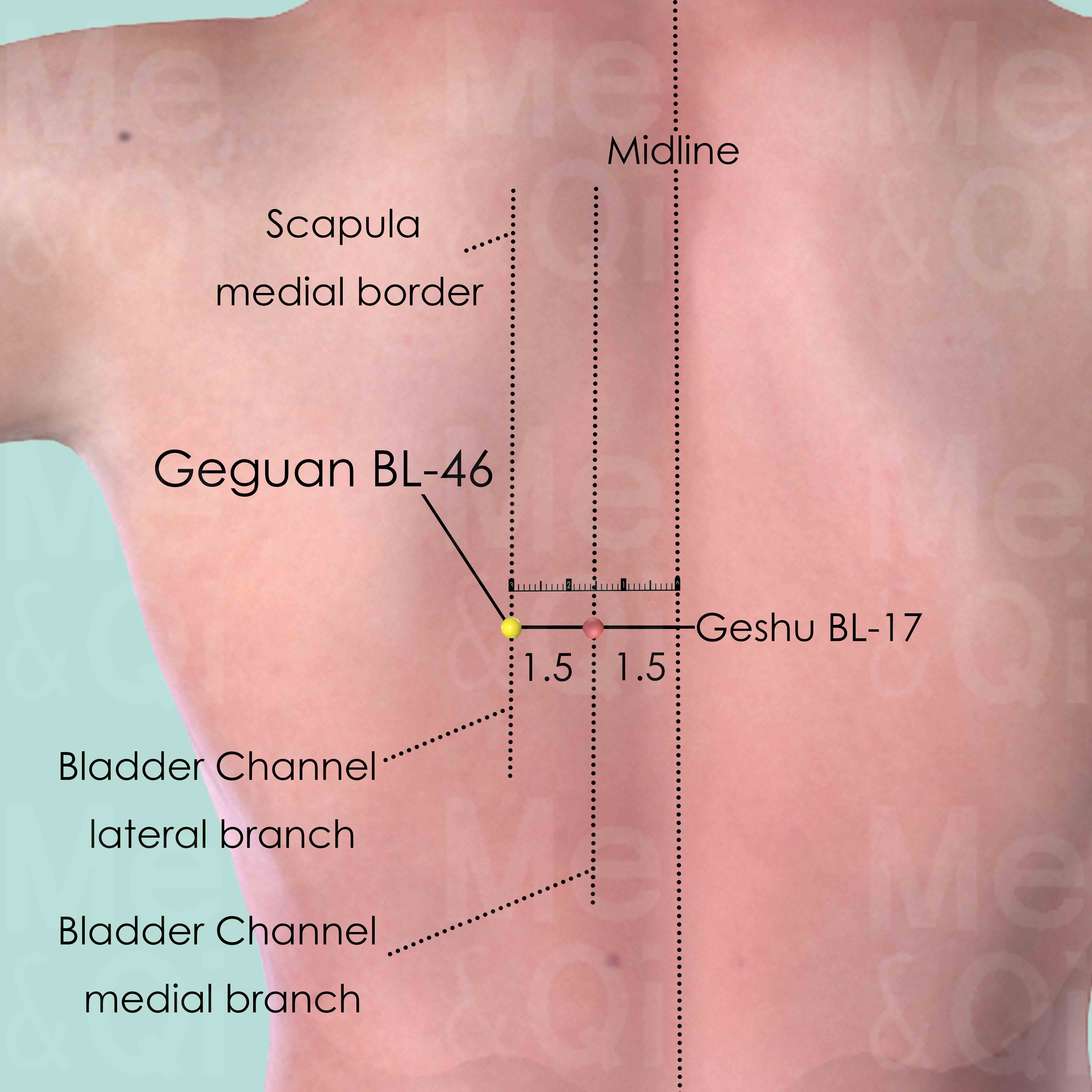
Geguan BL-46
3 cun (about 4 finger-breadths) lateral to the lower border of the spinous process of the 7th thoracic vertebra (T7).
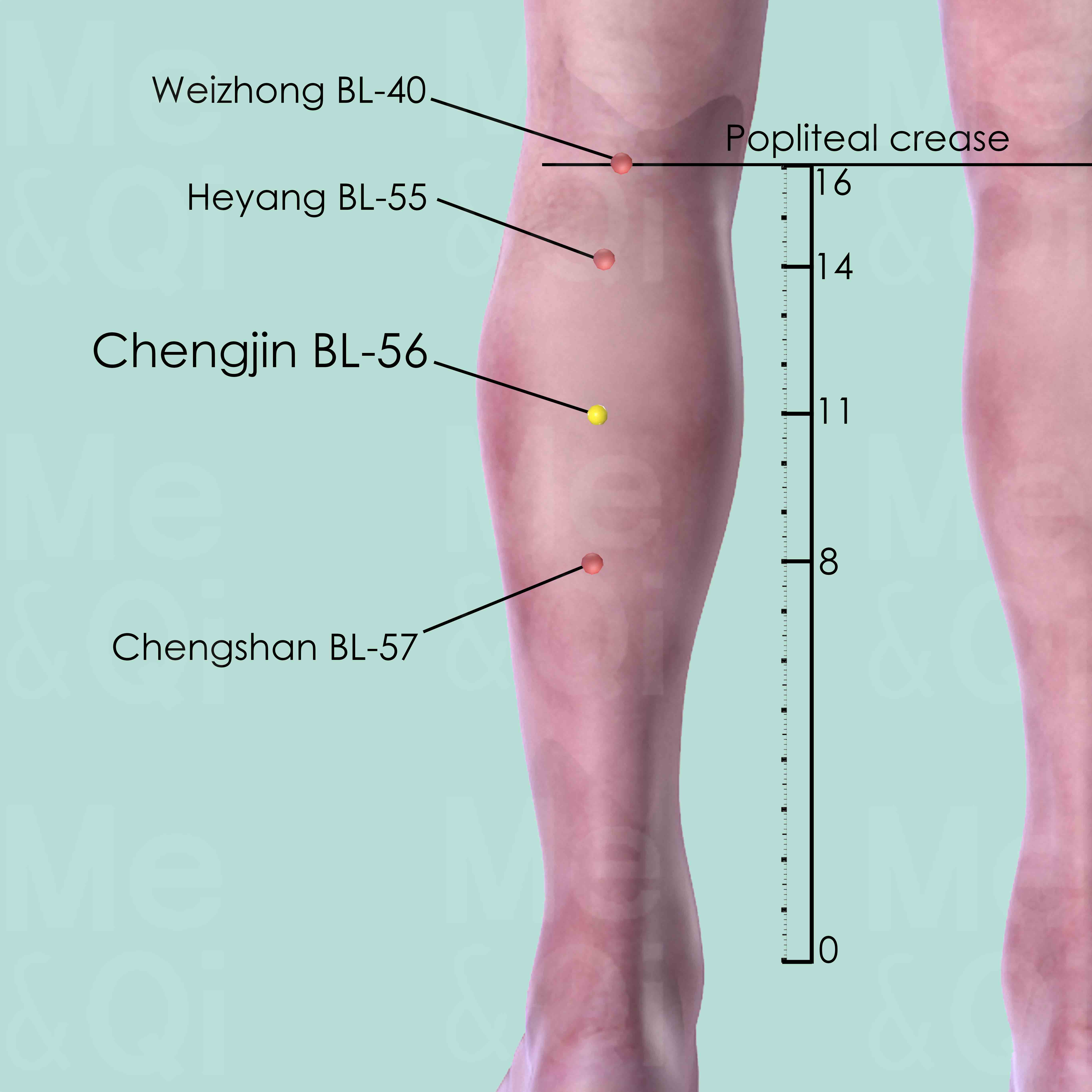
Chengjin BL-56
5 cun inferior to Weizhong BL-40 which is the midpoint of the popliteal crease. In the center of the belly of gastrocnemius muscle, midway between Heyang BL-55 and Chengshan BL-57.
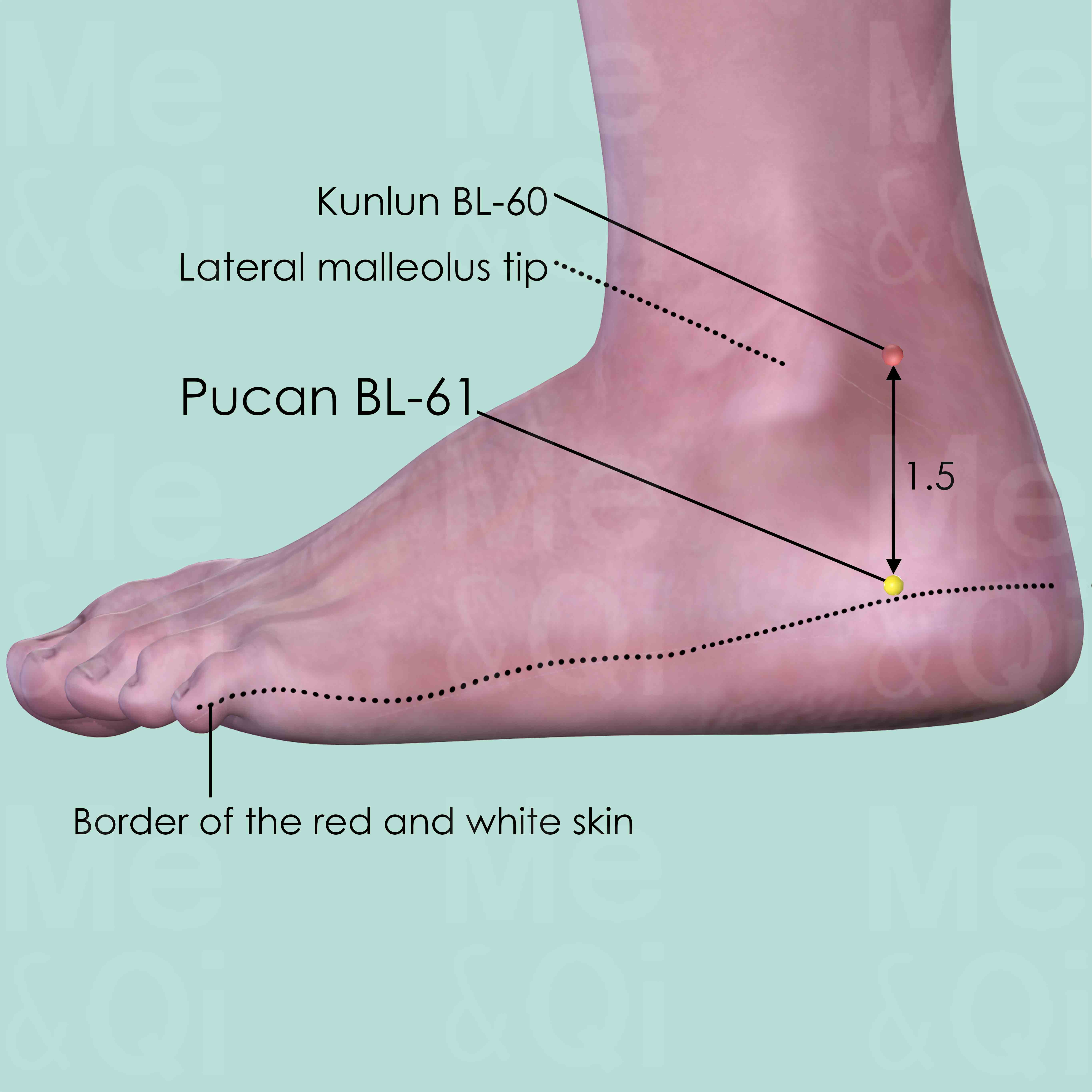
Pucan BL-61
Posterior and inferior to the external malleolus, directly below Kunlun BL-60, in the depression of the calcaneum at the junction of the red and white skin.
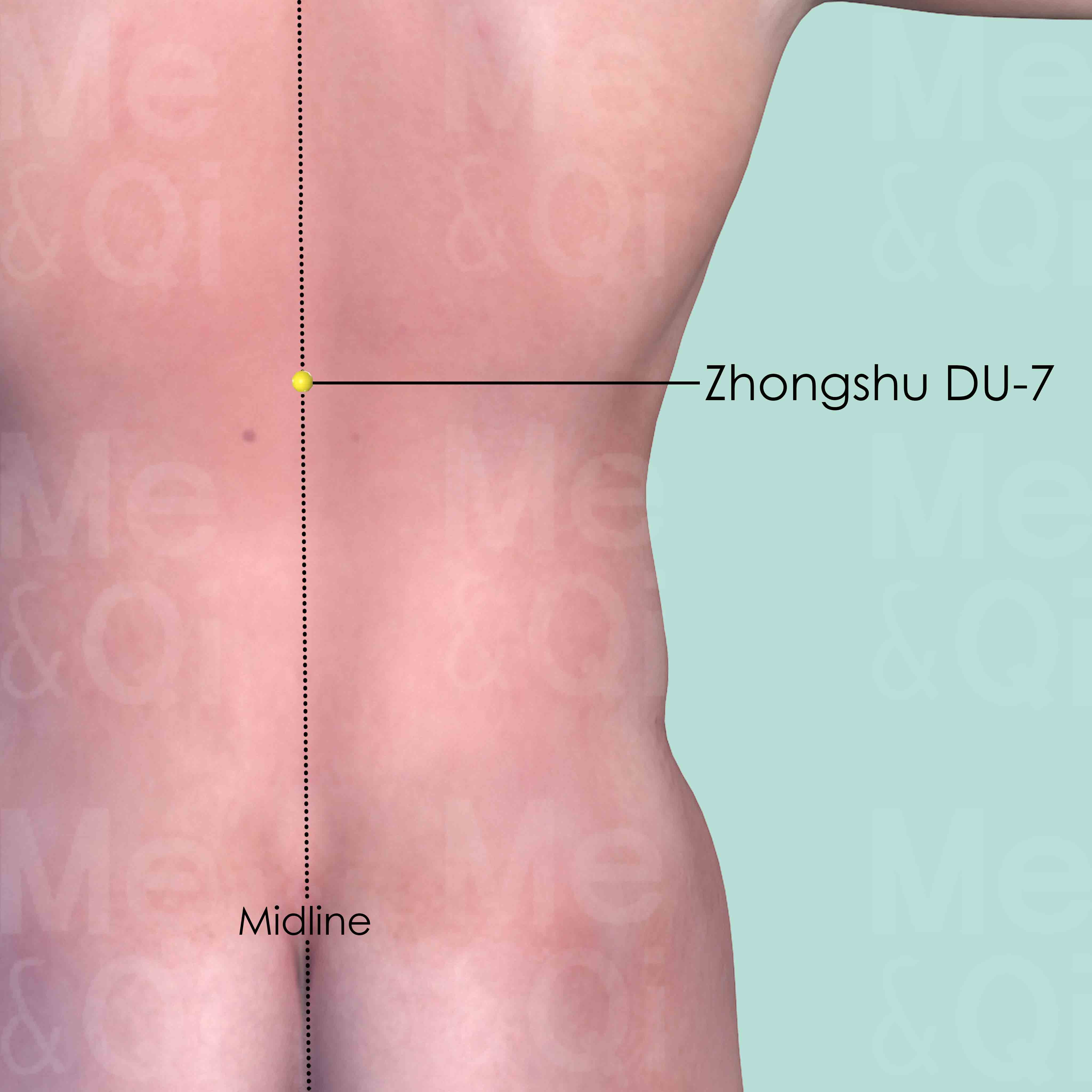
Zhongshu DU-7
On the back midline, in the depression below the spinous process of the 10th thoracic vertebra (T10).
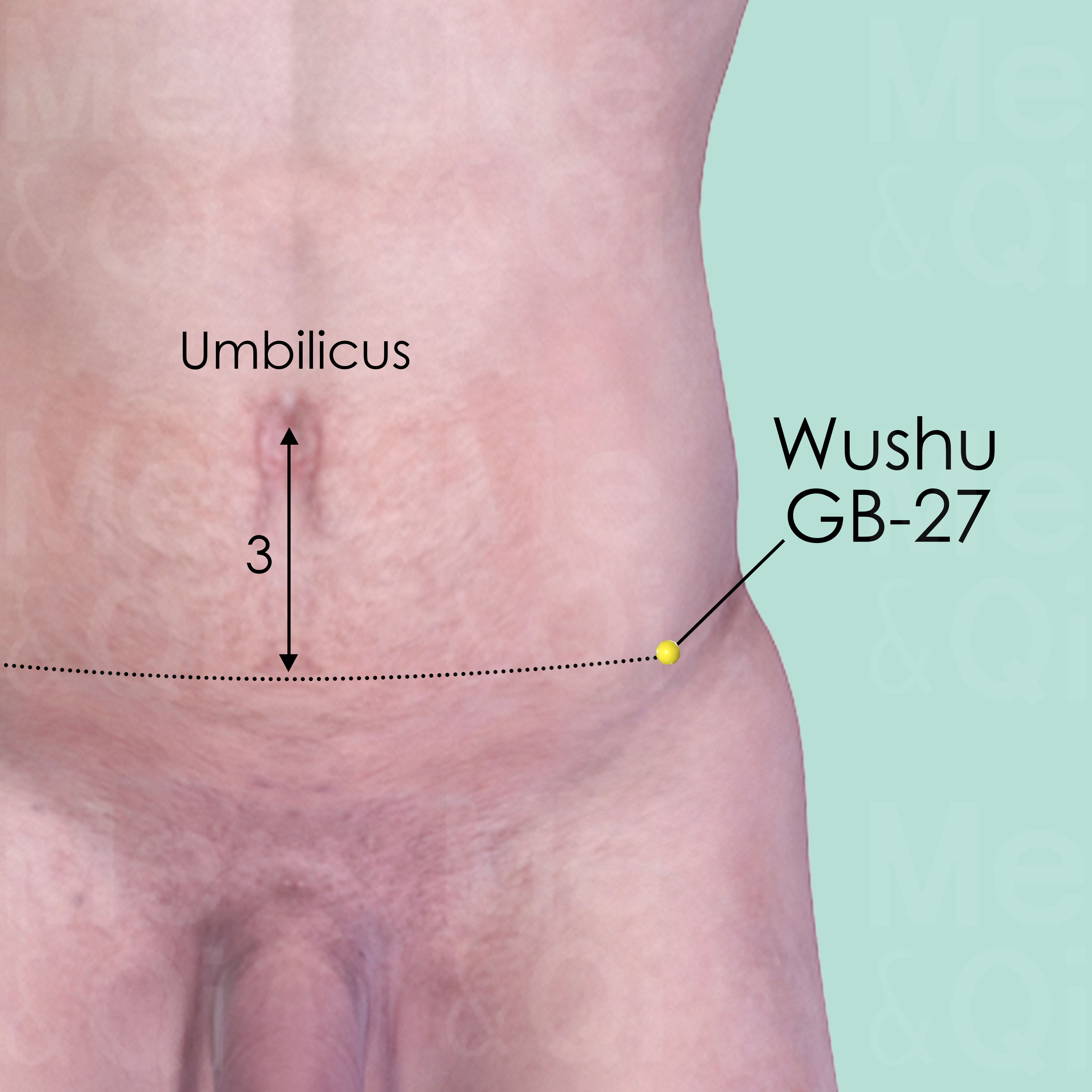
Wushu GB-27
In the lateral side of the abdomen, in the front of the anterior superior iliac spine (ASIS), 3 cun below the level of the umbilicus.
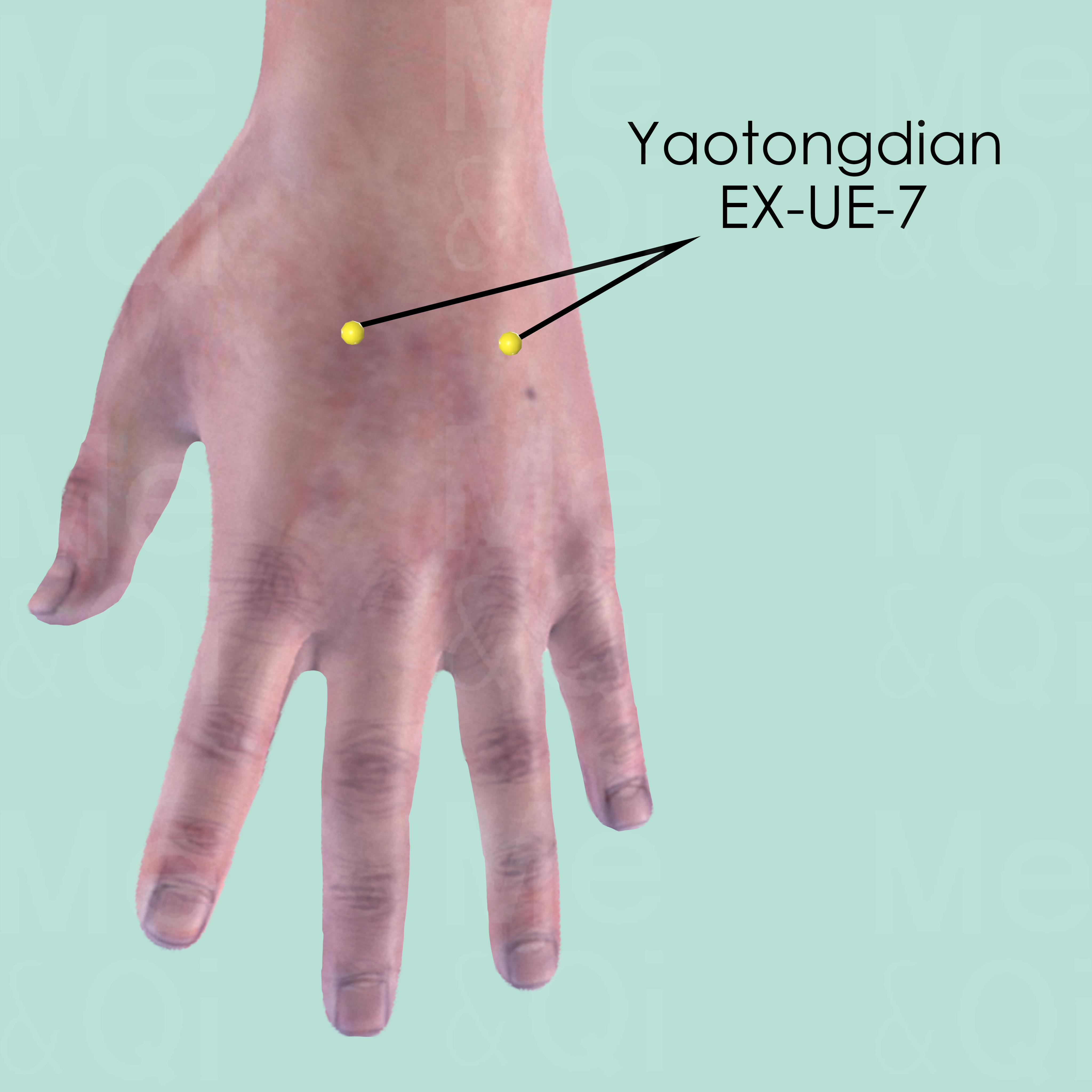
Yaotongdian EX-UE-7
This is a group of 2 points, located on the hand dorsum. One point is between the 2nd and 3rd metacarpal bones while the other is between the 4th and 5th. They are on the level of the junctions of the shaft and the base of the respective metacarpal bones.
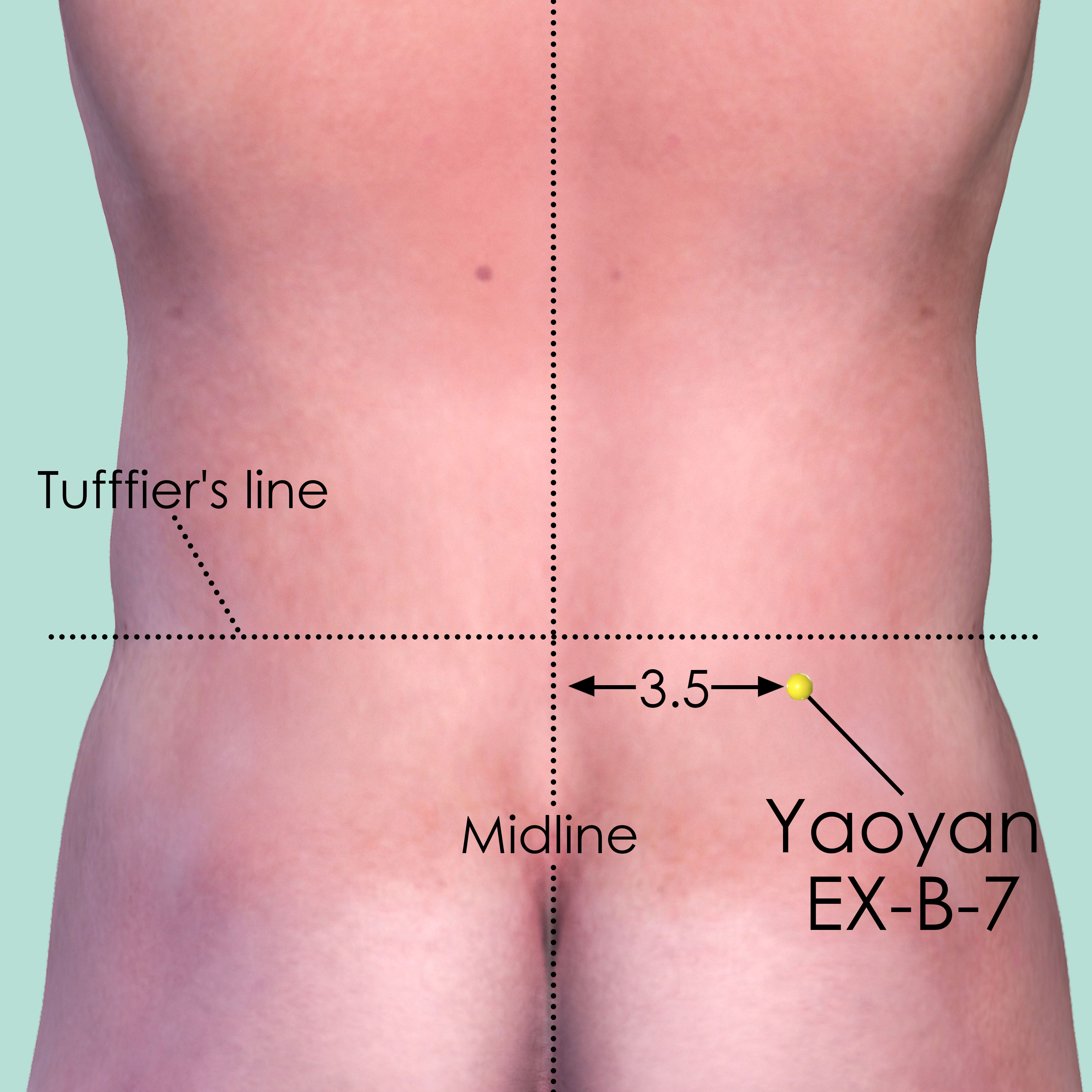
Yaoyan EX-B-7
3.5 cun lateral to the lower border of the spinous process of the 4th lumbar vertebra (L4).

